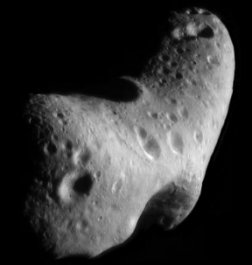X rays reveal Eros’ primitive nature
Aided by a blast of X rays from the sun, a spacecraft orbiting the near-Earth asteroid 433 Eros has gathered preliminary evidence that the rock is apparently unchanged since the birth of the solar system.

The finding supports the notion that Eros and other S asteroids, the most common class in the solar system, are the parent bodies of ordinary chondrites, the most common class of meteorites that fall to Earth.
Investigators with the Near-Earth Asteroid Rendezvous (NEAR) Shoemaker mission, which has orbited Eros since Feb. 14, benefited from a serendipitous event. For 30 minutes on May 4, a flare from the sun zapped the asteroid with X rays, prompting elements on Eros to emit their own X rays.
The intensity of the radiation allowed an X-ray spectrometer on NEAR Shoemaker to record a strong signal. Without a flare to trigger the X rays, the spectrometer would have required more time and a closer orbit. The craft is now 50 kilometers from the rock’s center but in July will descend 15 km lower.
The spectra reveal that the relative amounts of magnesium, silicon, and aluminum on Eros are the same as those in ordinary chondrites, which rank among the most primitive rocks in the solar system, says Jacob I. Trombka of NASA’s Goddard Space Flight Center in Greenbelt, Md.
He described the findings May 30 at the spring meeting of the American Geophysical Union in Washington, D.C. Trombka cautions that the spectrograph has to date examined only a 6-km-wide patch on the 34-km-long asteroid.
Among the planetary building blocks that arose from the disk of gas, dust, and ice around the infant sun, chondrites have a uniform mixture of heavy and light elements. This suggests that their parent asteroid never underwent melting and cooling, which would have separated lighter elements from heavier ones. The section of Eros so far examined seems to have the same uniform distribution.
Although astronomers suspected a link between S asteroids and ordinary chondrites, visible-light spectra from the bodies don’t quite match. Weathering can alter the surface of old asteroids and may account for the mismatch. Because the X rays induced by the sun come from just below Eros’ surface, they are a better indicator of the rock’s lineage, notes Richard P. Binzel of the Massachusetts Institute of Technology.







